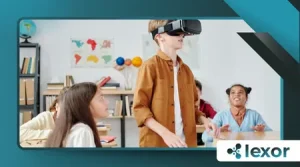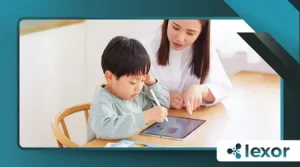Using Augmented Reality to Teach Shapes and Colors

Using Augmented Reality to Teach Shapes and Colors is revolutionizing early education, offering immersive, engaging experiences that transcend traditional methods.
This technology overlays digital information onto the real world, turning ordinary classrooms and homes into dynamic learning environments.
It moves beyond flat screens, making abstract concepts tangible for young, developing minds. Educators worldwide are noticing the profound effect on student engagement and retention.
AR promises to bridge the gap between theoretical knowledge and practical application. It’s a powerful tool, not a mere distraction, for the modern classroom.
How Does Augmented Reality Enhance the Perception of Basic Concepts?
AR captivates children by making learning an interactive adventure. Consider how a simple colored block can transform.
Through an AR app, that red block can instantly glow and pulsate with the vibrancy of the color itself. Children manipulate physical objects while simultaneously interacting with their digital counterparts.
This dual-modality approach significantly strengthens neural pathways related to visual and spatial recognition.
The playful nature of AR drives intrinsic motivation, crucial for sustained learning in early years.
Can AR Make Abstract Shapes Concrete for Young Learners?

For many preschoolers, understanding that a square is distinct from a triangle can be challenging. AR offers a solution by animating these concepts.
++Virtual Reality in Hospitality: Enhancing Guest Experiences
An AR application could project a 3D spinning cube onto a classroom table. The child can walk around it, seeing all six faces and edges, building a robust mental model.
This is profoundly different from merely seeing a picture in a book. It brings geometry, even at its most basic level, to life.
How Can AR Deepen the Understanding of the Color Spectrum?
Colors, though ubiquitous, require conscious association and naming. AR technology can use real-world objects to teach color recognition dynamically.
Read more: How to Introduce Coding to Kids Under 6
Imagine pointing a tablet at a yellow banana. The AR overlay identifies the color aloud and provides a list of other real-world yellow objects.
This immediate connection between the physical world and the learned vocabulary is remarkably effective. It makes the learning contextually relevant and highly memorable.
What Are the Tangible Benefits of Using Augmented Reality to Teach Shapes and Colors?
The adoption of AR in early childhood settings yields measurable and qualitative advantages. It fosters enhanced spatial reasoning skills from a very early age.
++Top 10 STEM toys for preschoolers in 2025
Furthermore, the interactive nature improves fine motor skills as children navigate the digital interfaces. A 2023 study published in the Journal of Educational Technology & Society confirmed these advantages.
The research, involving over 500 kindergarteners, demonstrated a 15% improvement in shape identification scores.
This was noted in groups Using Augmented Reality to Teach Shapes and Colors versus control groups using traditional flashcards.
++Impact of augmented reality technology on geometry skills and motivation of preschool children
AR is clearly an accelerator of foundational cognitive development.
| Benefit Area | Traditional Method (Flashcards/Books) | Augmented Reality (AR) Method |
| Engagement | Moderate, relies on instructor enthusiasm | High, interactive and immersive |
| Spatial Learning | Primarily 2D representation | True 3D visualization and interaction |
| Retention | Requires significant repetition | Enhanced by multi-sensory input |
| Motor Skills | Minimal interaction required | Requires active physical and digital navigation |
What Are Some Creative Examples of AR in Action?
Example 1: The ‘Shape-Sorter’ Digital Playground
A child holds a wooden block (e.g., a cylinder) while an AR app projects a virtual shape-sorting box onto the floor.
As the child moves the physical block, the AR environment guides the block towards the corresponding virtual hole.
A successful ‘sort’ is celebrated with a dynamic animation and the shape’s name spoken aloud. The physical action grounds the abstract concept.
Example 2: ‘Color Safari’ Interactive Experience
The teacher initiates a ‘Color Safari’ where children use tablets as their ‘binoculars.’ The AR app prompts them to find something ‘blue’ in the classroom.
When the tablet is pointed at a blue object, the object is virtually labeled “Blue” and a happy cartoon character pops up.
This turns a simple task into a fun, exploratory treasure hunt. This innovative approach makes learning a delightful game.
Why is AR a Superior Tool Compared to Static Digital Media?
Static digital media, like educational videos or basic games, is certainly beneficial. However, AR’s ability to blend the digital and physical worlds provides an unparalleled sensory experience.
It demands active participation rather than passive viewing. AR acts like a powerful learning analogy: if traditional learning is like looking at a picture of a bicycle, AR is like actually riding it.
One is theoretical, the other is practical and deeply ingrained. Using Augmented Reality to Teach Shapes and Colors fosters kinesthetic learning in a way flat-screen media simply cannot replicate.
Are There Ethical Considerations in Using Augmented Reality to Teach Shapes and Colors?
As with any technology in early education, careful implementation is key. Screen time must be thoughtfully balanced with physical play and social interaction.
Educators should ensure the AR content is age-appropriate, simple, and free of unnecessary distractions.
The technology should always serve as an enhancement, not a replacement, for human interaction and hands-on manipulation.
The focus must remain on developmental goals, not just the novelty of the tech.
Will AR Technology Become Standard Practice in Early Childhood Education?
Given the rapid advancements in mobile computing power and the falling cost of the hardware, widespread adoption is inevitable.
The efficacy of Using Augmented Reality to Teach Shapes and Colors is becoming increasingly clear to curriculum developers.
This method addresses the learning styles of the digital-native generation far better than previous methods.
How much longer will we rely primarily on methods developed for a pre-digital world?
This technology is poised to redefine foundational education within the next few years, offering richer, more meaningful early learning experiences.
The Future is Spatial: Concluding Thoughts on AR in Education
The journey to mastering fundamental concepts like shape and color is critical for future academic success. AR provides a state-of-the-art vehicle for this journey.
Using Augmented Reality to Teach Shapes and Colors is more than a trend; it’s a fundamental shift in pedagogy. It empowers both teachers and students with tools for immersive discovery.
The technology’s potential to make learning intuitive, interactive, and fun is enormous. Using Augmented Reality to Teach Shapes and Colors is the educational innovation we’ve been waiting for.
Frequently Asked Questions
Is Augmented Reality safe for young children’s eyes?
AR applications, when used on tablets or phones, are generally considered safe. However, experts recommend adhering to screen time guidelines set by pediatric associations, ensuring regular breaks and proper distance from the screen.
Does AR replace the need for physical toys and manipulatives?
Absolutely not. AR works best when it augments the real world. Physical toys and manipulatives are essential for developing fine motor skills and tactile learning, and AR is most effective when used in combination with these physical objects.
What kind of hardware is needed to implement AR learning?
Most modern smartphones and tablets are sufficient to run current educational AR applications. Dedicated AR headsets are becoming more common, but standard mobile devices are the entry point for most schools and homes.
How is AR different from Virtual Reality (VR) in the classroom?
Virtual Reality (VR) completely immerses the user in a digital world, cutting off the physical surroundings. Augmented Reality (AR) overlays digital content onto the user’s real-world view, which is preferable for young children as it keeps them grounded in their physical environment.
